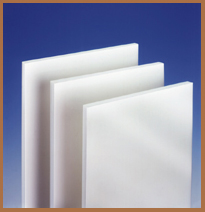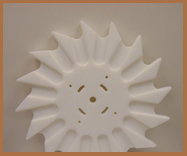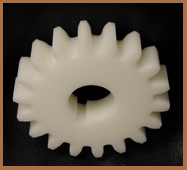|
Acetal Copolymer Compression vs. Extruded
The Big Question for Acetal Copolymer Users -
Compression Molded or Extruded?
Acetal copolymer users have
decided that the characteristics
of copolymer offer the
best choice for their machining
needs. They see advantages in the
fact that acetal copolymer offers no
centerline porosity and better
dimensional stability because of
lower crystallinity.
 Acetal copolymer
also provides improved hot water
and chemical resistance and is available
in medical grade formulations.
With the decision made to use acetal
copolymer, the question becomes
whether to choose extruded or compression
molded sheet.
Acetal copolymer
also provides improved hot water
and chemical resistance and is available
in medical grade formulations.
With the decision made to use acetal
copolymer, the question becomes
whether to choose extruded or compression
molded sheet.
Because of the improvements made in the extrusion
process, limitations that were once associated with acetal
copolymer extruded sheet are no longer valid. For example,
a few years ago common sizes ranged from 48 to 96
maximum. Today extruded sheet is available in sizes up to
48 x 120. In addition, a look at the mechanical properties
of both products and a comparison of stress levels
indicates that extruded acetal copolymer sheet may be
the better choice for a wide range of applications.
To make the comparison between compression molded
and extruded, two sizes of compression molded and
extruded acetal slab stock were analyzed (0.5 thick and
1.5 thick) for basic mechanical properties as well as
dimensional stability and dimensional consistency. For the
0.5 plate stock there were minimal differences in tensile
strength and tensile elongation. Tensile strengths were
approximately 8800 8900 psi. Elongations at break
were approximately 20 24%. Tensile modulus however
was significantly higher for the extruded product than
with compression molded acetal (394 kpsi vs 300 kpsi).
Acetal copolymer plates with thickness of 1.5 were also
analyzed in a similar fashion. The extruded product had a
tensile strength of 9800 psi vs 8600 psi for compression
molded plate. Tensile elongation was
almost twice as large for the extruded
product than for compression
molded plate (20 vs 12.9%). Tensile
modulus was much closer for extruded
and compression molded product
(370 kpsi vs 357 kpsi) Similarly flexural
strength and modulus were
comparable in both extruded and
compression molded product,
approximately 420 kpsi.
The overall internal stress was
analyzed for the extruded plates.
Samples 2 square were taken from
five areas across the width of the
plate to determine the variation of stress in the part.
Measurements were taken along the extrusion direction,
perpendicular to extrusion and through the thickness. The
compression molded product measurements were taken
in a similar fashion. The parts were heated to 300บF.
After six hours, the specimens were cooled slowly to room
temperature. The measurements were repeated and the
percent dimensional change was calculated.
For the 0.5 compression molded plate the dimensional
change was approximately 1% for the in-plane dimensions
and 4.5% for
the thickness.
 The high stress
in the thickness
would be expected
since
that would be
the direction of
compression in
the manufacturing
process. The
0.5 thick extruded
plate exhibited
significantly
smaller dimensional changes. The
extruded plate showed a 0.05% dimensional
change in the extrusion direction,
a 0.09% change perpendicular to
extrusion and 0% change in the thickness.
This indicates that the extruded
plate had a very low stress level.
The high stress
in the thickness
would be expected
since
that would be
the direction of
compression in
the manufacturing
process. The
0.5 thick extruded
plate exhibited
significantly
smaller dimensional changes. The
extruded plate showed a 0.05% dimensional
change in the extrusion direction,
a 0.09% change perpendicular to
extrusion and 0% change in the thickness.
This indicates that the extruded
plate had a very low stress level.
The 1.5 thick plates showed a similar
result. The 1.5 compression
molded plate had dimensional
changes of 1%, 0.7% and 2% in the
in-plane dimensions and thickness directions respectively.
The extruded slab again displayed much lower stress levels.
The extrusion and perpendicular dimensions only
changed approximately 0.1%. The thickness dimension
changed 0.07%. Per ASTM D 6100 the allowable dimensional
change is 0.4%.
The testing data indicates that the extruded acetal
copolymer products tested exhibited lower internal stresses
than the compression molded acetal copolymer stock
shapes tested.
 Lower internal stresses translate into flatter
material after machining and minimal dimensional change.
Therefore parts can be machined to higher tolerances and
minimal rework is required, thus reducing machining costs.
Extruded acetal copolymer stock shapes have excellent
machinability. Standard high speed tooling
can be used for milling, drilling, turning
and cutting. The material has good
chip forming capabilities when machined
and the low internal stress allows
machining to very high tolerances.
Extruded acetal copolymer shapes
have excellent wear characteristics. They
are ideal for bearing and bushing applications.
These extruded products have an
excellent combination of mechanical and
thermal properties which make them an excellent choice for
many applications in general industrial, food contact and
non-implant medical applications. The extruded acetal
copolymers that were tested meet or exceed the requirements
of ASTM D 6100 S-POM 0211LP and they comply
with the appropriate FDA regulations for direct food.
Lower internal stresses translate into flatter
material after machining and minimal dimensional change.
Therefore parts can be machined to higher tolerances and
minimal rework is required, thus reducing machining costs.
Extruded acetal copolymer stock shapes have excellent
machinability. Standard high speed tooling
can be used for milling, drilling, turning
and cutting. The material has good
chip forming capabilities when machined
and the low internal stress allows
machining to very high tolerances.
Extruded acetal copolymer shapes
have excellent wear characteristics. They
are ideal for bearing and bushing applications.
These extruded products have an
excellent combination of mechanical and
thermal properties which make them an excellent choice for
many applications in general industrial, food contact and
non-implant medical applications. The extruded acetal
copolymers that were tested meet or exceed the requirements
of ASTM D 6100 S-POM 0211LP and they comply
with the appropriate FDA regulations for direct food.
Written by Kenneth S. Grier, Manager, Technical
Resources, Ensinger-Hyde, a leading manufacturer of
plastic sheet and cast nylon shapes. Manufacturing capabilities
include extrusion, injection molding, compression
molding and cast nylon.
He can be reached at 856-227-
0500 ext. 1111, Fax: 856-232-1754, E-mail: kgrier@
alhyde.com.
|